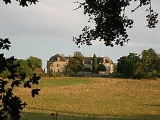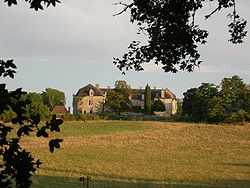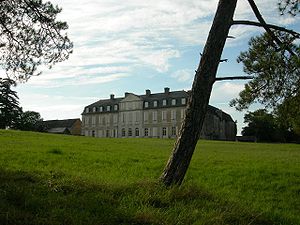
Pannonie
Encyclopedia

Rocamadour
Rocamadour is a commune in the Lot department in south-western France. It lies in the former province of Quercy.Rocamadour has attracted visitors for its setting in a gorge above a tributary of the River Dordogne, and especially for its historical monuments and its sanctuary of the Blessed Virgin...
, situated since the 19th century in the commune of Couzou
Couzou
Couzou is a commune in the Lot department in south-western France....
. Now, the village is near an old castle built in the 15th century and transformed during the 18th and 19th century.
Toponymy
The "Pannonie" name caused many papers and articles about the curious homonym form with the Hungarian Pannonia. In fact, near RocamadourRocamadour
Rocamadour is a commune in the Lot department in south-western France. It lies in the former province of Quercy.Rocamadour has attracted visitors for its setting in a gorge above a tributary of the River Dordogne, and especially for its historical monuments and its sanctuary of the Blessed Virgin...
, the cistercian monks of Obazine (Aubazine Abbey) created the first farm named like that. In order to be present near the famous medieval city of pilgrimage, these monks received fields and villages by donations and sellings. Realizing a new organisation, sometimes they preferred to use new names for their foundations.
The La Pannonie cistercian farm was built during the 13th century, near the ruined village of Saint-Circ (or Saint-Cyr d'Alzou).
Why "La Pannonie"?
- Did the faunFaunThe faun is a rustic forest god or place-spirit of Roman mythology often associated with Greek satyrs and the Greek god Pan.-Origins:...
"Pan" play music in La Pannonie? - The Christian devotion of Saint ApolloniaSaint ApolloniaSaint Apollonia was one of a group of virgin martyrs who suffered in Alexandria during a local uprising against the Christians prior to the persecution of Decius. According to legend, her torture included having all of her teeth violently pulled out or shattered...
- A Panho Family living here. Living in GramatGramatGramat is a commune in the Lot department in south-western France....
during the 14th century, this family could give its name to the area, like the Hebrards named the Hebrardie. - Hungarian Cistercian Monks. The medieval cistercian network could tell Hungarian farmers to cross Europe, because this new foundation needed new inhabitants.
- The "panage" old right, created since the Latin word panagium, this ancient right authorized farmers to keep their pigs near oaks eating acornAcornThe acorn, or oak nut, is the nut of the oaks and their close relatives . It usually contains a single seed , enclosed in a tough, leathery shell, and borne in a cup-shaped cupule. Acorns vary from 1–6 cm long and 0.8–4 cm broad...
s. Used during centuries, "panage" could become "pannonie".
Geography

Gramat
Gramat is a commune in the Lot department in south-western France....
limestone area, near the wild and spectacular Alzou (Ouysse) Valley, La Pannonie is a little village between Gramat
Gramat
Gramat is a commune in the Lot department in south-western France....
and Rocamadour
Rocamadour
Rocamadour is a commune in the Lot department in south-western France. It lies in the former province of Quercy.Rocamadour has attracted visitors for its setting in a gorge above a tributary of the River Dordogne, and especially for its historical monuments and its sanctuary of the Blessed Virgin...
. Situated in the Naturel Regional Park of the Causses of Quercy, this country is also referencied by the Natura 2000 network
Natura 2000
Natura 2000 is an ecological network of protected areas in the territory of the European Union.-Origins:In May 1992, the governments of the European Communities adopted legislation designed to protect the most seriously threatened habitats and species across Europe. This legislation is called the...
.
Fields or forest of La Pannonie are usually closed by stone low walls. This tradition is ancient as a specific art. Each year, people found stones in fields and built new low walls. After this common task, it was easier to plough, and to keep sheeps inside closed areas.
History
- Saint-Cyr d'Alzou, an ancient oppidum ruined at the end of the 12th century
Around the end of the 12th century, the Saint-Cyr oppidum was attacked by bands of bandits, forcing the lord and his family to flee from. Historians thought about the passage of Henry Curtmantle, gone here in 1183. This son of Henry II Plantagenet, king of England, looted Rocamadour before dying in Martel
Martel, Lot
Martel is a commune in the Lot department in south-western France.The town has a distinctive sky-line with medieval towers. There is a museum containing items from Puy d'Issolud, a local Gallic archaeological site which has been identified as Uxellodunum, besieged by Julius Caesar in 51 BC.Henry...
. This Saint-Cyr family (or Saint-Circ) could find protection in their suzerain's Castle, lord of Thégra
Thégra
Thégra is a commune in the Lot department in south-western France.- See also :* Communes of the Lot department...
. The youngest son of Saint-Cyr, named Uc (or Hugh), was born in that place. During his life, he became a very famous "troubadour" (medieval artist) in South of France, North of Italy, Portugal and Spain.
- The last cistercian farm of Obazine all around Rocamadour
During the 13th century, the Obazine Abbey (Aubazine
Aubazine
Aubazine is a commune in the Corrèze department in central France.-Population:-References:*...
) modified her network all around Rocamadour. After her farms in the Alix
Alix
Alix, or The Adventures of Alix, is a popular Franco-Belgian comics series drawn in the ligne claire style by one its masters, Jacques Martin. The stories revolve around a young Gallo-Roman man named Alix in the late Roman Republic...
, in Calès
Calès
Calès is the name of two communes in France:* Calès, Dordogne* Calès, Lot...
, in Couzou
Couzou
Couzou is a commune in the Lot department in south-western France....
, in Carlucet
Carlucet
Carlucet is a commune in the Lot department in south-western France....
, near Seniergues
Séniergues
Séniergues is a commune in the Lot department in south-western France.-Geography:The river Céou has its source in the commune and forms part of its southern border....
, in Bonnecoste
Calès, Lot
Calès is a commune in the Lot department in south-western France....
, cistercian monks built their last foundation in La Pannonie.
- The "causse" (limestone) of Gramat ruined by the Hundred Years War, famine and epidemics as the Black Death
The area of Gramat was depopulated in the 14th century. Bad harvests caused famines, and famines didn't stop epidemics like the Black Death
Black Death
The Black Death was one of the most devastating pandemics in human history, peaking in Europe between 1348 and 1350. Of several competing theories, the dominant explanation for the Black Death is the plague theory, which attributes the outbreak to the bacterium Yersinia pestis. Thought to have...
. During that period, the Dordogne River
Dordogne River
The Dordogne is a river in south-central and southwest France.-Name:Contrary to appearances, the name of the Dordogne is not a recent word resulting from the names of the Dore and the Dogne...
was a frontier with English Aquitaine
Aquitaine
Aquitaine , archaic Guyenne/Guienne , is one of the 27 regions of France, in the south-western part of metropolitan France, along the Atlantic Ocean and the Pyrenees mountain range on the border with Spain. It comprises the 5 departments of Dordogne, :Lot et Garonne, :Pyrénées-Atlantiques, Landes...
, and pillages by marauding mercenary armies were a frequent risk for people.
- The first castle of la Pannonie, built at the end of the 15th century
After war, the Obazine Abbey preferred rent out its fields and farms. Most of them were chosen by rich families, building there "repaires", sort of little fortificated castle. Traders living in the Caretta castle, in the city of Rocamadour
Rocamadour
Rocamadour is a commune in the Lot department in south-western France. It lies in the former province of Quercy.Rocamadour has attracted visitors for its setting in a gorge above a tributary of the River Dordogne, and especially for its historical monuments and its sanctuary of the Blessed Virgin...
, made the first castle of La Pannonie. Their name was "Lagrange", and the construction was made between the end of the 15th century and the first beginning of the 16th century. The de Lagrange kept their domain until the 17th century.
- The Vidal de Lapize, creators of the second and so classic and charming castle of la Pannonie

Rococo
Rococo , also referred to as "Late Baroque", is an 18th-century style which developed as Baroque artists gave up their symmetry and became increasingly ornate, florid, and playful...
style.
- During the French RevolutionFrench RevolutionThe French Revolution , sometimes distinguished as the 'Great French Revolution' , was a period of radical social and political upheaval in France and Europe. The absolute monarchy that had ruled France for centuries collapsed in three years...
, farmers helped their lord's family
Very happy in their peaceful castle of La Pannonie, the Vidal de Lapize suffered the French revolutionary period because of the emigration of Antoine and his sons. So farmers protected goods and castle, and they hided the youngest son Louis-Antoine as their own son. With their help, the two daughters could pay the castle, and they could live in their childhood that they loved.
- Other transformations at the end of the 19th century
At the end of the 19th century, Charles of La Pannonie, modified his castle and grounds, creating a new entrance and three ponds in a new English style grounds.
Well-known figures
- Famous troubadour Uc de Saint CircUc de Saint CircUc de Saint Circ or Hugues de Saint Circq was a troubadour from Quercy. Uc is perhaps most significant to modern historians as the probable author of several vidas and razos of other troubadours, though only one of Bernart de Ventadorn exists under his name...
, 13th century, born in ThégraThégraThégra is a commune in the Lot department in south-western France.- See also :* Communes of the Lot department...
but his father was the poor lord of Saint-Cyr, near La Pannonie. - Antoine Vidal de Lapize Lord of la Pannonie, nicknamed "Father of the Poor".
- Father de Lapize La Pannonie, who suffered the revolutionary French Terror in Paris. His account was known by the counter-revolutionary literature.
- Lady Marie-Thérèse and Lady Marie-Jeanne de Lapize de la Pannonie, "aunts of la Pannonie" who saved the castle after the French RevolutionFrench RevolutionThe French Revolution , sometimes distinguished as the 'Great French Revolution' , was a period of radical social and political upheaval in France and Europe. The absolute monarchy that had ruled France for centuries collapsed in three years...
. - Jacques Pélaprat, domestic. His souvenir is kept by the "Jacques House", near the castle.
- Charles Vidal de Lapize, Lord of la Pannonie, nicknamed the "Bon Monsieur Charles".
External links
- Official Website
- Historic Monuments – The Lot General Council Website
- Patrimoine de France
- Base Mérimée – The Mérimée Basis of the French Ministry of Culture

